
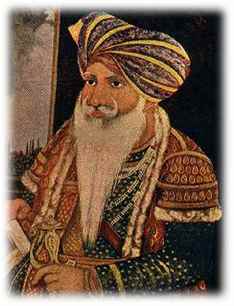
Killing a lion
He was only with the Maharaja for a few months when one day he was asked to accompany the Maharaja for a hunt. As they entered the forest, suddenly a man eating lion jumped on him and threw him on the ground. Hari Singh was completely caught unaware and did not even have the opportunity to draw his sword. But he got hold of the jaw of the lion and with great force flung the lion away, and withdrawing his sword, with one blow severed the lion's head. The Maharaja and the other courtiers were extraordinarily amazed at this feat. From that day onwards Hari Singh was given the appellation of "Nalwa" by the Maharaja, who acknowledged that Hari Singh had killed the lion similar to the way King Nall used to hunt (King Nall was a very brave king and was known for his audacity to kill lions and other dangerous animals with his bare hands, and hence the Maharaja adorned Hari Singh with that title i.e. "Nall-wa"- 'like Nall' )
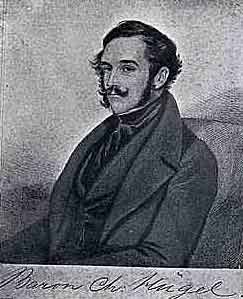
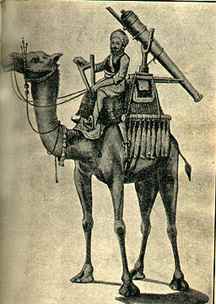
Cannon mounted on camel - a warfare weapon of Hari Singh Artillary - "Shutersvaar"
It was on the 24th of February 1810, that the Maharaja, along with Sardar Hari Singh Nalwa, attacked Multan. This was a very hard battle where the Multan Fort was fortified by the Nawab of Bahawalpur, and even after considerable bombardment the walls of the fort held on. It was suggested that if some warriors could reach the fort and place dynamite near the walls and blow the wall apart, the army then could enter the fort. This was a suicidal mission, but Sardar Hari Singh was the first volunteer to jump and except the challenge. He, along with 74 others did the needful and the Sikh army entered the fort and the battle was won, but Hari Singh was very seriously wounded, and had no hope of living. But after some time he recovered, to the delight of the Maharaja and the Sikh army, who now considered him an exceptional soldier, and was duly honored by the Maharaja with more estate and money. His further conquests included Mitha Tiwana, Uch, and the historic win over the Afghanis at the Attock Fort. Later on 20th April 1819, the Sikh army under the command of Sardar Hari Singh Nalwa attacked Kashmir. A very ferocious battle was fought but eventually Kashmir became a part of the Sikh Empire. Diwan Moti Ram was given the governorship of Kashmir, but he proved a weak administrator, and was replaced by Sardar Hari Singh Nalwa on 24th August 1820. Sardar Hari Singh governed Kashmir in such an excellent manner that the Maharaja was highly pleased with him, and to reward him, the Maharaja instructed the Kashmir mint to name the currency after Hari Singh Nalwa. The "Hari Singh Rupee" can presently be seen in museums. The Maharaja needed Hari Singh for other campaigns, and as the situation of Kashmir was under control, he requisitioned Hari Singh back to Lahore, where plans were discussed to bring more territories under the Sikh Raj. While returning from Kashmir Sardar Hari Singh conquered Mangli on the way, which was another great win. He reached Lahore on 28th November 1821, and the Maharaja was extremely overjoyed to see him and learn of the triumph of Mangli. The Sikh army started their campaign with taking Mungher, Hazara and Hari Pur, which was named after Sardar Hari Singh. At the fort of Khairababad, the Sikh army under the command of Sardar Hari Singh only nuimbered 8000 and the Afghani army numbered nearly 150000. But the sheer bravery and audacity of the Sikh warriors was enough to overcome such a powerful force. Sir Alexander Barnes in his book "Barnes Travels - in Bukhara" narrates this Sikh victory as a milestone in history. On thr 16th of October 1831 Sardar Hari Singh was amongst the prominent Sardars, who along with Maharaja Ranjeet Singh met the British Governor General Lord Bentick at the historic meeting of Ropar.
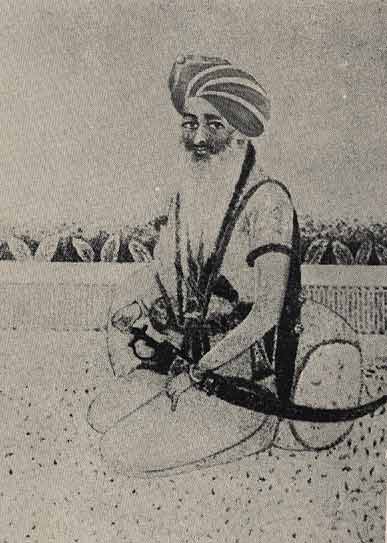
Peshawar
Peshawar was an Afghani stronghold for 836 years and even after innumerable attempts by the Hindus, it could not be defeated and it was the biggest hurdle which had to be overcome for the establishment of the Sikh Raj. A letter dated 12th May 1834 from Maharaja Ranjeet Singh to Captain Wad, Political Agent Ludhiana, states:- "By the Grace of God at present auspicious moment I have been delighted by the arrival of happy news. The Barkzai Sardars destitute of foresight had arrayed at the dawn of the day with about 12000 horse and foot in hostility against my troops. "Kanwar Nau Nihal Singh took a spear in his hand and prepared to oppose them with great presence of mind in concert with Hari Singh Nalwa and Mr. Court with a discharge of artillery. At length the Barkazais repining at their timidity sought safety in flight and being dispersed on all sides. Peshawar fell in the hands of officers of my Government who extended their protection to the inhabitants of that place and their property. In the evening there was illumination in the city which was hailed both by Hindus and Mohammedans of the country as the harbinger of their deliverance from the hands of their tyrants." The victory of Peshawar is one of the greatest victories of the Sikh Raj and it was mostly due to the generalship and boldness of Sardar Hari Singh Nalwa.
Jamraud
Jamraud is near the border with Afghanistan. Hari Singh sensing this had quite a few forts build in that area, but the main Fort of Jamraud has a great significance in history, as it was here that the great General Hari Singh met his death Sardar Hari Singh was called to defend the fort, which was undermanned and was subsequently attacked by the Afghanis from Kabul. The battle was nearly lost when Hari Singh arrived and turned the tables. It was his very name, which sent shudders of panic in the spines of the assailants. It was whiles chasing the enemy into the Khyber Pass, that Sardar Hari Singh was hit by two bullets in his chest. Hari Singh, though hit badly did not give any impression of being wounded, and returned straight to the Fort, where he was taken down from his horse His wounds were tended but he did not survive and the Sikh Raj was deprived of an exceptional man of distinguished valor. Sir Lepel Griffin, in his book 'The Punjab Chiefs' writes:-
"Hari Singh was struck by two balls, one in the side and the other in the stomach. He knew he was mortally wounded, but fearing to discourage his men, he turned his horse's head, and managed to ride as far as his tent. He swooned as he was taken from his horse, and half an hour later the bravest of the Sikh Generals, the man with the terror of whose name Afghan mothers used to quiet their fretful children was dead."
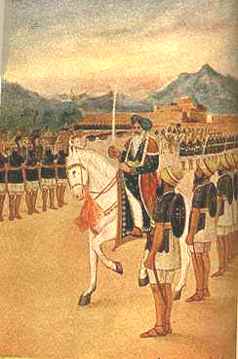
Sardar Hari Singh at Jamraud
The battle Ground of Jamraud-the last stand of the great Nalwa Sardar
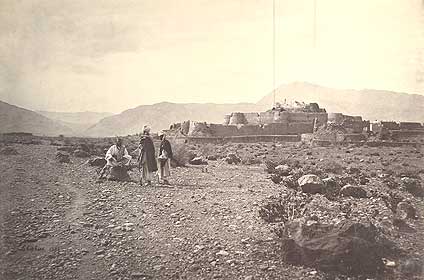
A rare photograph of the Jamraud Fort near the Khyber Pass
Sayyed Mohd. Lateef, in the "History of the Punjab writes;-"Such was the dread in which the Afghans held him, that to this day the name 'Haria' is repeated by mothers in Peshawar and its neighborhood in frightening their children."

The editor of the Tit Bits newspaper of England wrote in one of his columns around 1881:- "Some people might think that Napoleon was a great General. Some might name Marshall Hendenburgh, Lord Kitchener, General Karobzey or Duke of Wellington etc. And some going further might say Halaku Khan, Changez Khan, Richard or Allaudin etc. But let me tell you that in the North of India a General of the name of Hari Singh Nalwa of the Sikhs prevailed. Had he lived longer and had the sources and artillery of the British, he would have conquered most of Asia and Europe…."
No doubt - Sardar Hari Singh Nalwa was the Greatest General ever! Kadar Yaar, a Panjabi poet writes in the 'Hari Singh Nama', what Sardar Hari says to his horse, when he was hit by the bullets:-
"nUn inkl cl GoiVAw ikly dI vl, AsW pwvxw nhIN dUjI vwr Pyrw [
golI l`gI ey kihr klor vwlI, Gwiel hoieAw hY A`j svwr qyrw [
myry bWikAw CYl CbIilAw E, hYN quM sYAW mYdwnW dw Xwr myrw [
kwdr Xwr jy qUM lY clyN A`j fyry, qyrw kdy nw BulsI ipAwr Syrw [" *******************************************************************
"vw vigAw hvw dy vWg GoVw, ijvyN inkldw qIr kmwn ivcoN [
mwr cuMgIAW hrn dy vWg Xwro, auf igAw sI aus mYdwn ivcoN [
POjW isMGW dIAW ivcoN guzr igAw, lMG igAw sI lSkr pTwx ivcoN [
kwdr Xwr hT nwl srdwr bYTw, AYpr inkldI peI sI jwn ivcoN [" ********************************************************************
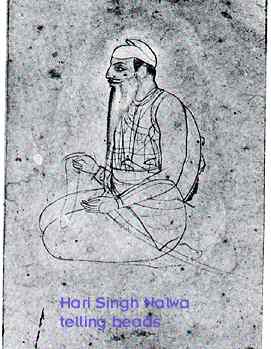
A very rare painting of the great Sikh Hero, Hari Singh Nalwa from the Lahore Museum (Courtesy F.Aijzzudin)
A sketch (the face fully painted) of Hari Singh Nalwa, seated on the ground and telling beads. His long white beard almost reaches his waist. He wears a compact white turban. In keeping with his martial naturehe is fully armed even during prayers.
COMMENT: The most famous and feared of Sikh generals, Hari Singh began his military career in Kasur while in his teens. His abilities were quickly recognised by MaharajaRanjit Singh who rewarded him with the governorships of Kashmir (1820). Hazara (1823), and later the control of Peshawar (1835). In 1836 Hari Singh built Jamraud Fort.
The Austrian traveller, Baron Hugel, recorded this recollection of his visit to Hari Singh's palace-fort at Guseraoli (near Wazirabad) in January 1836: "Hari Singh's manner and conversation are very frank and affable: and having acquainted myself beforehand with the history of this most distinguished member of Ranjit's court. I surprised him by my knowledge whwncw he had gained the appellation of Nalwa, and of his having cloven the head of a tiger who had already seized him as its prey. He told the Diwan to bring some drawings and gave me his portrait, in the act of killing the beast. Hari Singh Nalwa was the person sent by Ranjit to invite Lord William Bentick to confer with the Maharaja at Simla; and as I happened to know most of the persons he had met there, our conversation was very different from the majority of such interviews in India, and really consisted of a due exchange of ideas, and of references to events which had actually taken place. His questions proved him to have thought and reasoned justly; he is well informed on the statistics of many of the European States, and on the policy of the East India Company, and, what is very rare among the Sikhs, he can both read and write the Persian language (Hugel (1845), 254-255)
Hari Singh Nalwa died fighting the Pathan forces of Dost Mohammed Khan of Afghanistan. He was cremated in the Jamraud Fort & his TOMB was built by Babu Gajju Mall Kapur there

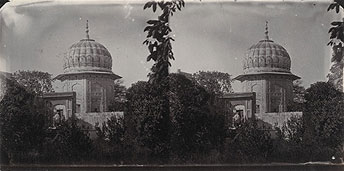
Tomb in memory of S. Hari Singh Nalwa at Gujranwala, his home town.
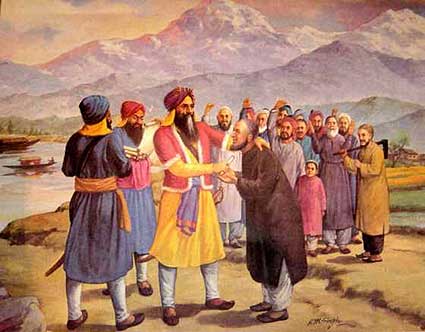
Hari Singh was made the Governor of Kashmir where he made the people of Kashmir his friends with his benevolent nature.
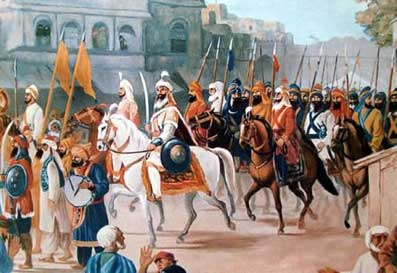
S. Hari Singh Nalwa heads into Jamraud with his victorious army

General Hari Singh Nalwa (photo courtsey The Sikhs)

S. Hari Singh Nalwa passes justice in a court ( page from a manuscript - early 20th century)
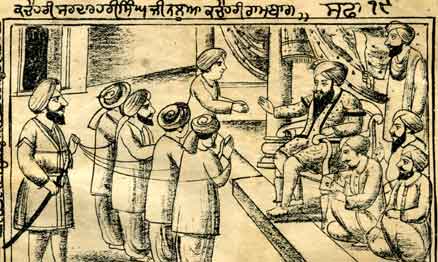
Another scene of a court with the Nalwa Sardar as the judge. (see above)
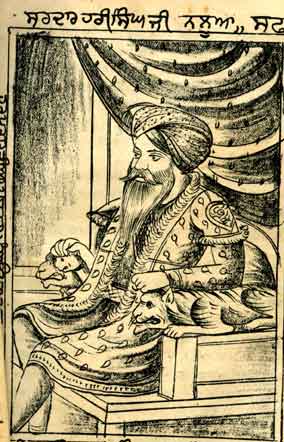
Portrait of S. Hari Singh Nalwa - from the same manuscript.
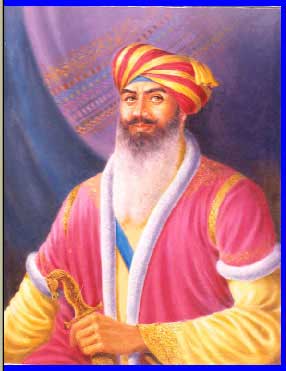
A portrait of Sardar Hari Singh by artist Devender Singh
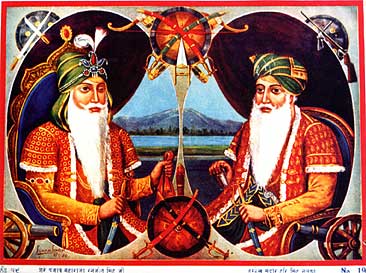
Maharaja Ranjit Singh with his greatest General S. Hari Singh Nalwa
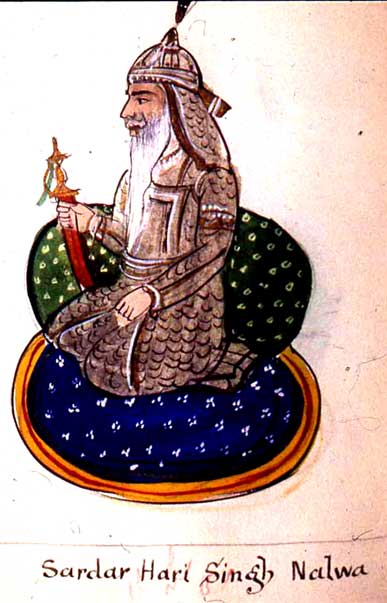
(photo courtesy royal asiatic society)
GENEOLOGY OF S.Hari Singh Nalwa as supplied by Ms. Vanit Nalwa a seventh generation descendant of the great Sikh General, who is living in New Delhi and is managing the Hari Singh Nalwa Trust. She is a trained neuro-psychologist and hypnotherapist . My sincere thanks to her. (Kanwal). FOLLOWING IS AN APPEAL BY VANIT NALWA (You can e/mail me any thing connected with S. Hari Singh Nalwa (Kanwal))
see also web site: http://www.harisinghnalwa.com/index.html